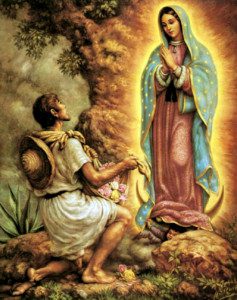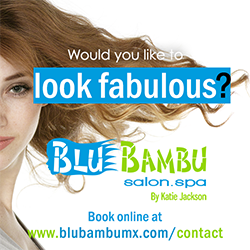Cozumel History: Morenita: Virgin Guadalupe
Cozumel History:The Morenita: The Virgin of Guadalupe
The Morenita: The Virgin of Guadalupe
Monica Sauza explains the significance of the Iconic Virgin….
 One of many consequences of the Spanish conquest (1519-1521) was religious syncretism. This merger of beliefs, amongst others, brought about one of the most respected images of the catholic faith: The Virgin of Guadalupe. The Aztecs worshipped Tonantzin: ‘Mother Earth’, ‘Goddess of Sustenance’, ‘Honored Grandmother’, ‘Mother of Corn’, ‘the Mother of Everything that Exists’; this was a wide-ranging name given to Aztec goddesses.
One of many consequences of the Spanish conquest (1519-1521) was religious syncretism. This merger of beliefs, amongst others, brought about one of the most respected images of the catholic faith: The Virgin of Guadalupe. The Aztecs worshipped Tonantzin: ‘Mother Earth’, ‘Goddess of Sustenance’, ‘Honored Grandmother’, ‘Mother of Corn’, ‘the Mother of Everything that Exists’; this was a wide-ranging name given to Aztec goddesses.
Following the arrival of the Conquistadors many temples were destroyed as it was thought that the indigenous people worshipped the devil. Upon the hill of Tepeyac, outside Mexico City, Aztecs had built a temple devoted to Tonantzin.
In their continuous efforts to convert the people into the new religion, the Spaniards demolished the Aztec temple and built a chapel on the Tepeyac dedicated to Virgin Mary; but the indigenous peoples continued addressing her as Tonantzin.
The Miracle, as the apparitions of the Virgin are known, was transmitted orally; and around 1540 the narration in Náhuatl, the Aztec language, was written in a text known asNicam Mopahua. The oldest copy is in the Public Library of New York, Rare Books and Manuscripts Department.
It is believed that in her apparitions Virgin Mary used the Náhuatl term Coatlaxopeuh which, when pronounced, sounds like “cuatlasupe,” phonetically similar to the name Guadalupe. Coa means snake and xopeuh means crush. Thus it is believed that Our Lady must have referred herself as “the one that crushes the snake.” The name she was then given was: Tonantzin-Guadalupe.
Ten years after the Spanish conquest, on December 9, 1531 at dawn, Juan Diego Cuauhtlatoatzin, ‘he who speaks like an eagle’, a devoted mid-fifties widower, was walking to attend mass at a church nearby in Tlatelolco. As he passed Tepeyac, he suddenly heard beautiful music, songbirds, saw a strange glimmer at the top of the hill and a soft voice calling him: “Juanito; dear Juan Dieguito”. When he reached the top, he saw a beautiful girl surrounded by a rainbow and bathed in celestial splendor. She said: “I am Virgin Mary, Mother of the one true God.” She revealed to him her wish: that a temple built in that place, that as a merciful mother she would profess all her love and compassion to all who dwelled in that land and sought her protection; there she would listen to their sorrows, cure their sufferings and afflictions.“…Run now and tell the Lord Bishop what you have seen and heard….”
The Bishop politely told Juan Diego he would consider the Lady’s request. On December 10, the second apparition, Juan returned discouraged to the hill and found the Virgin waiting for him. Juan Diego asked her to find someone more suitable to deliver the message; “I have chosen you for this task, there are many I could send…tomorrow morning go to the Bishop and tell him the holy Virgin Mary, Mother of God, sends you and repeat my wishes.” Surprised to see Juan Diego again, the Bishop told him to ask the Virgin for a sign. On the third apparition, Juan conveyed the message to the Virgin who, in turn, asked him to return the following morning, but Juan Diego’s uncle, Juan Bernardino, fell ill so he stayed home with his dying uncle. Early on December 12, Juan Diego went looking for a priest who could give his uncle the last blessings; he avoided walking through the route where he had met the Virgin, but she intercepted him. He apologized and explained his uncle’s conditions. Mary said, “The smallest of my children, do not be distressed and afraid. Am I not here I who am your Mother? … Your uncle will not die at this time. His health is restored. Go to the top of the hill; cut the flowers that are growing there and bring them to me.” Juan Diego was obedient but could not believe he would find flowers in the cold of December. When he reached the hilltop he found beautiful roses, cut them and wrapped them in his tilma (rough cloak) and returned to Mary. “My little son, this is the sign I am sending the Bishop…Remember son, you are my trusted ambassador; this time the Bishop will believe you.”
That was the last time Juan Diego saw the Virgin. Juan Diego explained to the Bishop what had passed, and unwrapped his tilma. The roses fell to the ground. . The Bishop fell on his knees as the image of the Blessed Virgin appeared imprinted on the tilma. While Juan Diego was calling on the Bishop, the dying uncle, suddenly found his room filled by a soft light. A glowing young woman appeared. She said he would get well and that she had sent his nephew, Juan Diego, to the Bishop with an image of herself and said, “Call me and call my image Our Lady of Guadalupe.”
In 1666 the chapel at the hilltop of Tepeyac was built and as too many pilgrims came to visit the Lady, a larger one was built in the XVIth. Century. By 1904 it was considered a Basilica, and the construction of the current and much larger Basilica began in 1974, next to the original one and to the Convent of the Capuchin nuns, where the image of the Virgin of Guadalupe is housed.
It is estimated that the Basilica receives up to 10 million devoted pilgrims every year. Respects have been paid to the Virgin of Guadalupe not only by Popes but also by Tibetan monks who honored her with their chants. Pope John Paul II declared the Virgin of Guadalupe as the Patron of the Americas (1999), all the way from Canada to Tierra del Fuego, and canonized Juan Diego in 2000. Her image has suffered serious assaults but has come unscathed from corrosive acids and even a bomb in 1921; the resulting damage bent a metal crucifix next to the image, but both the protecting glass and the image of the Virgin were undamaged. Her image, which has no brush strokes, and particularly her eyes, has been scientifically examined, even by NASA.
In Mexico, the Virgin of Guadalupe is the image par excellence that represents the faith of many Catholics.
Note: Morenita is an affectionate way of calling a woman of tanned complexion
La Morenita: La Virgen de Guadalupe
Mónica Sauza explica la importancia de la emblemática Virgen. . .
Una de las muchas consecuencias de la conquista española (1519-1521) fue el sincretismo religioso.

Esta fusión de creencias, entre otras, dio origen a una de las imágenes más respetada de la fe católica: La Virgen de Guadalupe. Los aztecas veneraban a Tonantzin: la Madre Tierra, Diosa del Sustento, Venerada Abuela, Madre del Maíz, Madre de todo lo que Existe; este era el nombre general que se daba a las diosas aztecas. Posterior a la llegada de los conquistadores, se destruyeron muchos templos pues se creía que los indígenas adoraban al diablo.
Sobre el cerro del Tepeyac, en las afueras de la Ciudad de México, los aztecas habían erigido un templo dedicado a Tonantzin. En sus esfuerzos continuos por convertir a la gente dentro de la nueva religión, los españoles demolieron el templo azteca y construyeron una capilla sobre el Tepeyac dedicada a la Virgen María; sin embargo, los indígenas continuaron llamándola Tonantzin.
El Milagro, como se le conoce a las apariciones de la Virgen, fue transmitido de manera oral. Alrededor del año 1540 la narración en náhuatl (la lengua de los aztecas) fue escrita en un texto conocido como Nicam Mopahua. La copia más antigua se encuentra en la Biblioteca Pública de Nueva York, en el Departamento de Libros y Manuscritos Raros. Se cree que durante sus apariciones la Virgen María utilizo el termino náhuatlCoatlaxopeuh el cual, al pronunciarse, suena como “quatlasupe“, fonéticamente similar al nombre Guadalupe. Coa significa víbora y xopeuh significa aplastar. Por lo tanto, se cree que Nuestra Señora se refirió a sí misma como “la que aplasta a la víbora”. El nombre que entonces se le daba era: Tonantzin-Guadalupe.
Diez años después de la conquista española, el día 9 de diciembre del año 1531, Juan Diego Cuauhtlatoatzin, “el que habla como un águila”, un hombre viudo y devoto de cincuenta y cinco años de edad, se dirigía a oír misa a una iglesia cercana en Tlatelolco. Al pasar por Tepeyac, repentinamente escucho una bella música, cantos de aves, vio un extraño resplandor en la cima, y una suave voz le llamaba: “Juanito; querido Juan Dieguito”. Al llegar a la cima, vio una bella joven rodeada por un arco iris y bañada en resplandor celestial. Ella le dijo: “Soy la Virgen María, Madre del único y verdadero Dios”. Le revelo su deseo: que un templo fuera construido en ese lugar, que como madre piadosa profesaría todo su amor y misericordia a todos los que habitaban en esa tierra y que buscaran su protección; ahí ella escucharía sus penas, sanaría su sufrimiento y aflicciones. “…Ahora ve y di al Señor Obispo todo lo que has visto y escuchado…”.
El Obispo amablemente dijo a Juan Diego que consideraría la solicitud de la Señora. Desalentado, el 10 de Diciembre, la segunda aparición, Juan regresó al cerro y encontró a la Virgen esperándole. Juan Diego le pidió que encontrara a alguien más apropiado para llevar el mensaje; “Te he elegido para esta tarea, hay muchos a los que podría enviar…mañana por la mañana ve con el Obispo y dile que la Santa Virgen María, Madre de Dios, te envía y repite mis deseos”. Sorprendido de ver a Juan Diego de nuevo, el Obispo dijo a Juan Diego que pidiera a la Virgen una señal. En la tercera aparición, Juan Diego transmitió el mensaje a la Virgen quien, a su vez, le pidió que regresara la mañana siguiente, sin embargo Juan Bernardino, tío de Juan Diego, enfermó y Juan Diego se quedó en casa con su tío moribundo. Temprano por la mañana del 12 de Diciembre, Juan Diego salió a buscar a un cura que pudiera dar a su tío la última bendición. Evitó pasar por la ruta donde se había topado con la Virgen, pero ella lo interceptó. Él se disculpó y le explicó la condición de su tío. María dijo: “El más pequeño de mis hijos. No te aflijas ni temas. ¿Acaso no estoy aquí, yo que soy tu Madre?…Tu tío no fallecerá ahora. Su salud ha sido restaurada. Sube el cerro, corta las flores que ahí nacen y tráemelas”. Juan Diego era obediente, pero no creía encontrar flores en el frío clima del mes de diciembre.
Al llegar a la cima encontró bellas rosas, las cortó, las envolvió en su tilma, y regresó con María. “Mi pequeño hijo, este es el signo que envío al Obispo…Recuerda hijo, eres mi leal embajador; en esta ocasión el Obispo te creerá”. Esa fue la última ocasión que Juan Diego vio a la Virgen. Juan Diego explico al Obispo lo que había sucedido y desató su tilma. Las rosas cayeron al suelo. El Obispo cayó de rodillas ante la imagen de la Virgen que aparecía impresa en la tilma.
Mientras Juan Diego estaba con el Obispo, su tío moribundo de repente encontró que su habitación se iluminaba con una luz tenue. Una joven radiante apareció. Le explicó que él se aliviaría y que había enviado a Juan Diego, su sobrino, ante el Obispo con una imagen de ella misma, y dijo: “Llámame y llama a mi imagen Nuestra Señora de Guadalupe”.
* La capilla en la cima del Tepeyac fue construida en el año 1666 y en virtud de que muchos peregrinos visitaban a la Señora, se construyó una más grande alrededor del año 1749. Para el año 1904 se le consideró Basílica, y la construcción de la Basílica actual de mucho mayor tamaño comenzó en el año 1974, junto a la original y junto al Convento de las monjas capuchinas, donde se resguarda la imagen de la Virgen de Guadalupe.
Se estima que la Basílica recibe anualmente hasta 10 millones de peregrinos devotos. La Virgen de Guadalupe ha sido honrada no solo por Papas sino también por monjes tibetanos quienes lo hicieran con sus cantos. El Papa Juan Pablo II declaró a la Virgen de Guadalupe como la Patrona de las Américas (1999), desde Canadá hasta Tierra del Fuego, y canonizó a Juan Diego en el año 2000. La imagen de la Virgen ha sufrido serios ataques, pero ha salido incólume de ácidos corrosivos e incluso de una bomba en el año 1921; los daños consecuentes doblaron un crucifijo que se encontraba junto a la imagen, en tanto que el cristal protector y la imagen de la Virgen quedaron intactos. Su imagen, que no tiene pincelada alguna, y en particular sus ojos, ha sido examinada por científicos, incluyendo a la NASA.
En México, la Virgen de Guadalupe es la imagen por excelencia que representa la fe de muchos católicos.
Otra fugitiva de la Ciudad de México. Mónica ha hecho de Cozumel su hogar definitivo. Desde su llegada en 1981, trabajo en turismo en todos los lugares habituales: hoteles, buceo, aeropuerto, ferries, hasta que se abrió la oportunidad de desempeñarse en su campo. Desde finales de la década de los años 70 Mónica ha estado traduciendo e interpretando, dedicándose plenamente a ello a partir de 1998, y ha asistido a extranjeros y locales de la Isla a establecer su residencia y sus negocios. Es traductora con gran experiencia, ávida historiadora y una gran fuente de tradiciones y leyendas locales.
- Mexican History 3 Kings Day - January 8, 2025
- 2025 Mexican National Holidays - January 3, 2025
- Mayan Weather Predictions - January 2, 2025
Another escapee from Mexico City, Monica has made Cozumel her definite home. Since her arrival -in 981- she worked in tourism in all the usual venues: hotels, scuba diving, airport, ferries, until the opportunity to practice in her chosen field grew. Since the latter part of the 70s Monica has been translating and interpreting, fully devoting herself to it since 1998, and has assisted foreigners and Island residents establish residence and businesses- She is a Translator with extensive experience, an avid historian and a great source of local lore and legends. Otra fugitiva de la Ciudad de México. Mónica ha hecho de Cozumel su hogar definitivo. Desde su llegada en 1981, trabajo en turismo en todos los lugares habituales: hoteles, buceo, aeropuerto, ferries, hasta que se abrió la oportunidad de desempeñarse en su campo. Desde finales de la década de los años 70 Mónica ha estado traduciendo e interpretando, dedicándose plenamente a ello a partir de 1998, y ha asistido a extranjeros y locales de la Isla a establecer su residencia y sus negocios. Es traductora con gran experiencia, ávida historiadora y una gran fuente de tradiciones y leyendas locales.
Cozumel Punta Sur Road Repair
Cozumel Punta Sur Road Repair Cozumel’s Punta Sur Road to Have...
Mexican History 3 Kings Day
Mexican History 3 Kings Day The Significance of January 6th & February...
New Year’s Traditions Mexico
New Year’s Traditions Mexico New Year’s Traditions and Rituals in Mexico....
Mayan Weather Predictions
Mayan Weather Predictions Honoring Traditions: “Las Cabañuelas,” Mayan Weather Predictions The weather...

















Leave a comment